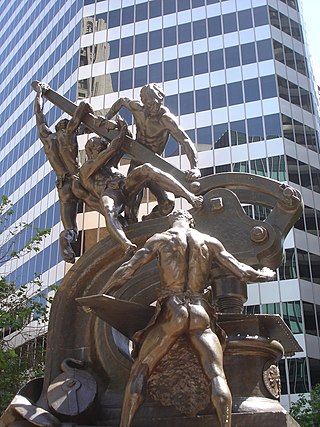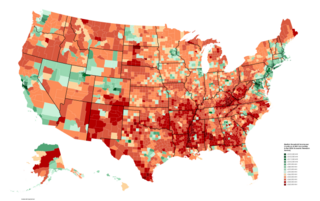
A secretary, administrative assistant, executive assistant, personal secretary, or other similar titles is a person whose work consists of supporting management, including executives, using a variety of project management, program evaluation, communication, and/or organizational skills within the area of administration. There is a diverse array of work experiences attainable within the administrative support field, ranging between internship, entry-level, associate, junior, mid-senior, and senior level pay bands with positions in nearly every industry, especially among white-collar careers.

Social class in the United States refers to the idea of grouping Americans by some measure of social status, typically by economic status. However, it could also refer to social status and/or location. The idea that American society can be divided into social classes is disputed, and there are many competing class systems.

A white-collar worker is a person who performs professional service, desk, managerial, or administrative work. White-collar work may be performed in an office or other administrative setting. White-collar workers include job paths related to government, consulting, academia, accountancy, business and executive management, customer support, design, economics, engineering, market research, finance, human resources, operations research, marketing, public relations, information technology, networking, law, healthcare, architecture, and research and development. In contrast: blue-collar workers perform manual labor or work in skilled trades; pink-collar workers work in care, health care, social work, or teaching; and grey-collar jobs combine manual labor and skilled trades with non-manual or managerial duties.
White collar may refer to:

In sociology, the upper middle class is the social group constituted by higher status members of the middle class. This is in contrast to the term lower middle class, which is used for the group at the opposite end of the middle-class stratum, and to the broader term middle class. There is considerable debate as to how the upper middle class might be defined. According to sociologist Max Weber, the upper middle class consists of well-educated professionals with postgraduate degrees and comfortable incomes.

An office lady, often abbreviated OL, is a female office worker in Japan who performs generally pink-collar tasks such as secretarial or clerical work. Office ladies are usually full-time permanent staff, although the jobs they perform usually have relatively little opportunity for promotion, and there is usually the tacit expectation that they leave their jobs once they get married.

A pink-collar worker is someone working in the care-oriented career field or in fields historically considered to be women's work. This may include jobs in the beauty industry, nursing, social work, teaching, secretarial work, upholstery, or child care. While these jobs may also be filled by men, they have historically been female-dominated and may pay significantly less than white-collar or blue-collar jobs.

The Australian Services Union is a trade union representing workers in a variety of industries.
A medical assistant, also known as a "clinical assistant" or healthcare assistant in the US is an allied health professional who supports the work of physicians, nurse practitioners, physician assistants and other health professionals, usually in a clinic setting. Medical assistants can become certified through an accredited program. Medical assistants perform routine tasks and procedures in a medical clinic.
PATCOB are occupational categories established by Equal Employment Opportunity Commission (EEOC). They are used for statistical reporting on data collected by the United States Census Bureau, employer reports or federal agencies.

The Office and Professional Employees International Union (OPEIU) is a trade union in the United States and Canada representing approximately 88,000 white-collar working people in the public and private sectors. It has members in all 50 US states, the District of Columbia, and Puerto Rico, as well as in one local in Canada.

Household income is an economic standard that can be applied to one household, or aggregated across a large group such as a county, city, or the whole country. It is commonly used by the United States government and private institutions to describe a household's economic status or to track economic trends in the US.
Though the American middle class does not have a definitive definition, contemporary social scientists have put forward several ostensibly congruent theories on it. Depending on the class model used, the middle class constitutes anywhere from 25% to 75% of households.
The United States federal civil service is the civilian workforce of the United States federal government's departments and agencies. The federal civil service was established in 1871. U.S. state and local government entities often have comparable civil service systems that are modeled on the national system to varying degrees.

Affluence refers to an individual's or household's economical and financial advantage in comparison to others. It may be assessed through either income or wealth.
The terms average Joe, ordinary Joe, Joe Sixpack, Joe Lunchbucket, Joe Snuffy, Joe Blow, Joe Schmoe and ordinary Jane, average Jane, and plain Jane are used primarily in North America to refer to a completely average person, typically an average American. It can be used both to give the image of a hypothetical "completely average person" or to describe an existing person. Parallel terms in other languages for local equivalents exist worldwide.
In sociology, the upper middle class of the United States is the social group constituted by higher-status members of the middle class in American society. This is in contrast to the term lower middle class, which refers to the group at the opposite end of the middle class scale. There is considerable debate as to how the upper middle class might be defined. According to Max Weber, the upper middle class consists of well-educated professionals with graduate degrees and comfortable incomes.
Collar color is a set of terms denoting groups of working individuals based on the colors of their collars worn at work. These can commonly reflect one's occupation within a broad class, or sometimes gender; at least in the late 20th and 21st century, these are generally metaphorical and not a description of typical present apparel. For the two terms of longest use, white-collar workers are named for the white-collared shirts that were fashionable among office workers in the early and mid-20th century. Blue-collar workers are referred to as such because in the early 20th century, they usually wore sturdy, inexpensive clothing that did not show dirt easily, such as blue denim or cambric shirts.
In the United States, the concept of a working class remains vaguely defined, and classifying people or jobs into this class can be contentious. Economists and pollsters in the United States generally define "working class" adults as those lacking a college degree, rather than by occupation or income. Many members of the working class, as defined by academic models, are often identified in the vernacular as being middle-class, there is considerable ambiguity over the term's meaning. According to Frank Newport, "for some, working class is a more literal label; namely, an indication that one is working." Sociologists such as Dennis Gilbert and Joseph Kahl see the working class as the most populous in the United States, while other sociologists such as William Thompson, Joseph Hickey and James Henslin deem the lower middle class slightly more populous. In the class models devised by these sociologists, the working class comprises between 30% and 35% of the population, roughly the same percentages as the lower middle class. According to the class model by Dennis Gilbert, the working class comprises those between the 25th and 55th percentile of society. In 2018, 31% of Americans self described themselves as working class. Retired American adults are less likely to describe themselves as "working class", regardless of the actual income or education level of the adult.
A clerk is a senior official of many municipal governments in the English-speaking world. In some communities, including most in the United States, the position is elected, but in many others, the clerk is appointed to their post. In the UK, a town or parish clerk is appointed by the town or parish council members. In almost all cases, the actual title of the clerk reflects the type of municipality they work for; thus, instead of simply being known as the clerk, the position is generally referred to as the town clerk, township clerk, city clerk, village clerk, borough clerk, board secretary, or county clerk. Other titles also exist, such as recorder and corporate officer. The office has existed for centuries, though in some places it is now being merged with other positions.









